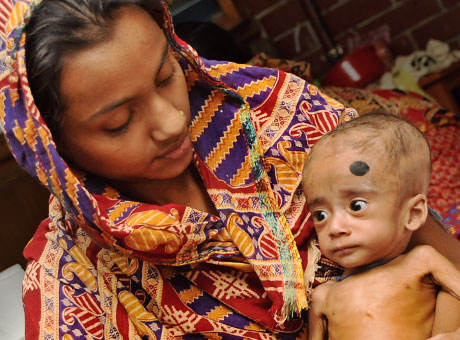
A Bangladeshi mother holds her malnourished child. The dark spot placed on his head is said to ward off evil spirits.

A Bangladeshi mother holds her malnourished child. The dark spot placed on his head is said to ward off evil spirits.
New findings may help explain why millions of malnourished children suffer from stunted growth and fail to thrive after treatment with nutrient-rich therapeutic foods.
Studying healthy and malnourished young children in Bangladesh, a team at the School of Medicine found that malnutrition has persistent detrimental effects on the vast community of microbes living in the gut. These “friendly” microbes typically aid in extracting nutrients and calories from food, and perform many other vital functions.
The results suggest that the long-term consequences of childhood malnutrition, such as stunted growth, cognitive problems and weakened immune systems, may be rooted in lingering, underdeveloped gut microbes that can’t fully harvest energy and calories from food, said senior author, Jeffrey I. Gordon, MD, director of Washington University’s Center for Genome Sciences & Systems Biology.
In healthy children, the researchers identified features associated with normal development of the gut’s community of microbes. In comparison, they noted that malnourished children carried communities of gut microbes that did not mature along a normal trajectory. These immature bacterial collections could not be restored to good health with standard treatments of therapeutic foods.
The research, conducted in collaboration with colleagues at the International Centre for Diarrhoeal Disease Research in Dhaka, Bangladesh, is published online in Nature.
“Although therapeutic food-based interventions have resulted in a significant decline in deaths from malnutrition, many children never fully recover,” said first author Sathish Subramanian, a Washington University MD/PhD student. “We found that children who were malnourished had gut microbial communities that were not consistent with their chronological ages. The severity of a child’s malnourishment was tied closely with the degree of immaturity of his or her gut microbial community, and this immaturity could not be durably repaired with standard treatments.”
The researchers are following up their research in animal models colonized with immature gut microbe communities from malnourished children. They are seeking to determine whether giving therapeutic foods for longer periods of time or administering beneficial mixtures of naturally occurring human gut microbes can repair this immaturity and improve health.